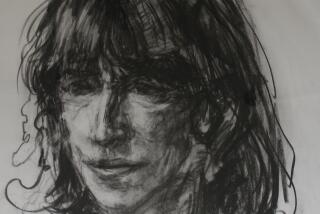Handedness Theory Takes a Left Turn : THE LEFT-HANDER SYNDROME; The Causes & Consequences of Lefthandedness, <i> by Stanley Coren,</i> The Free Press, $24.95; 308 pages
- Share via
It was frustrating for both of us, the time I tried to teach my daughter how to tie a bow. I failed, but she did learn eventually. I’d forgotten the incident until I read on her college application: “The most significant experience of my life was being born left-handed.
“I have always had to figure out how to do things most people take for granted,” she wrote, “like using a scissor. I have been forced to show initiative and accept being different.”
Her paternal grandfather had consoled her. At least she would not be forced to write with the wrong hand. No one doubted that she had inherited his handedness.
Now Stanley Coren in “The Left-hander Syndrome” has convinced me that we were wrong. Handedness does not fit any hereditary pattern and is one trait often not shared by identical twins.
Not inherited, but pathological? Coren, psychology professor at the University of British Columbia, defines pathology as a deviation from normal development, and then demonstrates that left-handedness is probably just that in most instances.
An overwhelming 87% of us use our right hands for small muscle activities (such as writing or sewing). We also favor our right feet (should we play soccer) and our right ears and eyes. And we veer to the right when we enter a room.
That leaves 13% of the population eating, writing and scratching their noses with their left hands. Even those, like my father-in-law, who were bullied into writing with their right hands continue to do everything else with the left.
Coren explains how handedness is related to “laterality,” the way specialized areas of each hemisphere of the brain control vision, speech and movement. Although he errs when he asserts that humans alone show handedness--a study published last fall describes distinct handedness in lemurs--he is right about the degree of lateralization in the human brain.
This laterality, he emphasizes, is not especially neat. There is no evidence that the left side of the brain--the side responsible in right-handed people for linear thinking--dominates and represses the intuitive impulses in the right hemisphere.
Psycho-Neuro-Astrology is Coren’s term for the fad of “right-brain” or “two-mind” theories. Referring to the path-breaking experiments on epileptics to determine the different functions of the brain’s hemispheres, Coren points out that these experiments did not find that one hemisphere dominated the other. Coren blames sloppy journalists for reducing the scientific reports on laterality to pop science, dividing the world into “left-brainers”--emotionless automatons doing physics and practicing law--and “right-brainers,”--intuitive, creative and hopelessly inarticulate artists.
He recounts the print odyssey of Doreen Kimura, a psychologist at the University of Western Ontario in London, Ontario, who told a scientific symposium that melodies heard by the left ear were more easily recognized than those heard by the right. Kimura concluded that the right hemisphere processes music faster than the left, that “the recognition of melodies is better in the right hemisphere.”
The first newspaper account in the New York Times announced: “Musical ability controlled by right brain.” The story was then picked up by a syndicate that added: a “London psychologist, Dr. Doreen Kimura, claims that musicians are right-brained.” And after a few months Kimura surfaced again, this time in a magazine article that described Kimura as “an English psychologist who has finally explained why so many great musicians are left-handed.”
But are the brains of artists somehow wired differently? Coren reports how researchers decided to investigate by hooking up EEGs to the skulls of lawyers (notoriously left-brained) and sculptors (likewise right-brained). They found the same patterns of electrical activity distributed over the two hemispheres in each group.
This is not to say that left-handers’ brains work just like right-handers’. The pathology that may account for left-handedness also seems to enhance math and imaging skills and to heighten susceptibility to allergies and other autoimmune diseases.
This heightened susceptibility may explain a puzzling demographic blip: the gradual disappearance of left-handers in older age groups. The evidence is damning: Lefties die younger. They may succumb to the stress of living in a lopsided world or from autoimmune diseases. Many die in accidents resulting from maladaptation to right-handed technology.
Coren concludes with a spirited call to arms against “handism.” He urges lefties to organize, to emerge from their cloak of invisibility by insisting that handedness be noted on medical records and drivers’ licenses, and that society make concessions (e.g. new machinery design) to their sinistrality.
Although right-handed, Coren has a soft spot for lefties. More than once in this rich account of the history, anthropology and neurobiology of handedness he reminds us that left-handers are a desirable variation from the norm. They figure disproportionately among the gifted, running the gamut from Leonardo to Lewis Carroll, Benjamin Franklin to Ronald Reagan.
Next: Jonathan Kirsch reviews “Stolen Continents” by Ronald Wright (Houghton Mifflin).





